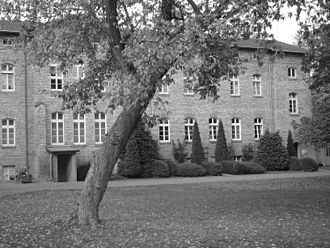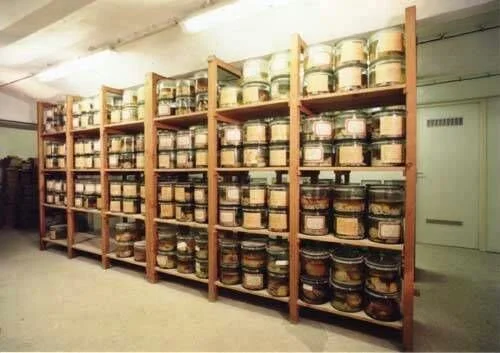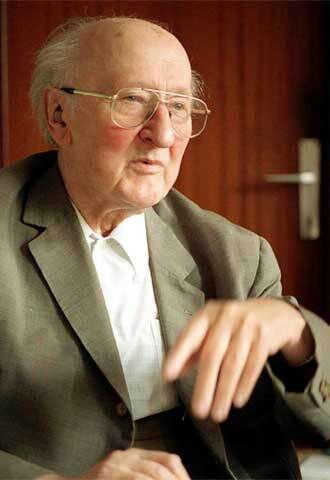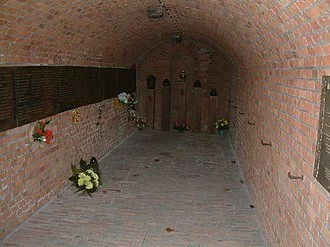
Aktiön T4
The Nazi Eugenics Program
The term "eugenics" was first used towards the end of the nineteenth century by the British scientist Francis Galton (1822-1911) to describe the intervention in genetic makeup in humans. Under the Nazi regime, however, the term took on a bitter connotation and degenerated into a true genocide. The story:
The impetus
Already in 1925, when his book "Mein Kampf" was published,Hitlerleft no doubt that, in the long run, only the Aryan race had a right to exist. When the National Socialists came to power in 1933, the racial improvement of the German people was high on the agenda. Thus, with the introduction of the Nuremberg Racial Laws, sexual relations and marriages between Aryans and non-Aryans were banned. Almost at the same time, the "Lebensborn project" was also launched, which aimed to increase the birth rate of purebred Aryan children.
The plans are being worked out
In 1939, on Hitler's orders, a "Sonderprogramm" was started to guarantee the racial purity of the Germanic people. To achieve this, the program provided for the forced sterilization of so-called racially inferior populations and for the euthanasia of people with a mental disorder or physical disability. The project was named "Aktion T4", referring to the "Tiergartenstraβe 4", the address where the offices of the "Sonderprogramm" were located in Berlin.
Implementation
Karl Brandt, doctor to Hitler and Hans Lammers, the head of the Reich Chancellery, testified after the war that Hitler had told them as early as 1933—when the sterilisation law was passed—that he favoured the killing of the incurably ill but recognised that public opinion would not accept this. In 1935, Hitler told the Leader of Reich Doctors, Gerhard Wagner, that the question could not be taken up in peacetime; "Such a problem could be more smoothly and easily carried out in war". He wrote that he intended to "radically solve" the problem of the mental asylums in such an event. Aktion T4 began with a "trial" case in late 1938. Hitler instructed Brandt to evaluate a petition sent by two parents for the "mercy killing" of their son who was blind and had physical and developmental disabilities. The child, born near Leipzig and eventually identified as Gerhard Kretschmar, was killed in July 1939. Hitler instructed Brandt to proceed in the same manner in all similar cases
Hitlers Doctor Karl Brandt
Head of Reich Doctors Gerhard Wagner
On 18 August 1939, three weeks after the killing of the boy, the Reich Committee for the Scientific Registering of Hereditary and Congenital Illnesses was established to register sick children or newborns identified as defective. The secret killing of infants began in 1939 and increased after the war started; by 1941, more than 5,000 children had been killed. Hitler was in favour of killing those whom he judged to be lebensunwertes Leben ('Life unworthy of life'). A few months before the "euthanasia" decree, in a 1939 conference with Leonardo Conti, Reich Health Leader and State Secretary for Health in the Interior Ministry, and Hans Lammers, Chief of the Reich Chancellery, Hitler gave as examples the mentally ill who he said could only be "bedded on sawdust or sand" because they "perpetually dirtied themselves" and "put their own excrement into their mouths". This issue, according to the Nazi regime, assumed a new urgency in wartime.
After the invasion of Poland, Hermann Pfannmüller (Head of the State Hospital near Munich) said
“It is unbearable to me that the flower of our youth must lose their lives at the front, so that that feeble-minded and asocial element can have a secure existence in the asylum.”
The Killing centres
Extermination centres were established at six existing psychiatric hospitals: Bernburg, Brandenburg, Grafeneck, Hadamar, Hartheim, and Sonnenstein. One thousand children under the age of 17 were killed at the institutions Am Spiegelgrund and Gugging in Austria. They played a crucial role in developments leading to the Holocaust. As a related aspect of the "medical" and scientific basis of this programme, the Nazi doctors took thousands of brains from 'euthanasia' victims for research.
The Nazi Euthanasia Centre at Bernburg
The Brandenburg Euthanasia Centre
From August 1939, the Interior Ministry registered children with disabilities, requiring doctors and midwives to report all cases of newborns with severe disabilities; the 'guardian' consent element soon disappeared. Those to be killed were identified as
"all children under three years of age in whom any of the following 'serious hereditary diseases' were 'suspected': idiocy and Down syndrome (especially when associated with blindness and deafness); microcephaly; hydrocephaly; malformations of all kinds, especially of limbs, head, and spinal column; and paralysis, including spastic conditions".
The reports were assessed by a panel of medical experts, of whom three were required to give their approval before a child could be killed.
The Ministry used deceit when dealing with parents or guardians, particularly in Catholic areas, where parents were generally uncooperative. Parents were told that their children were being sent to "Special Sections", where they would receive improved treatment. The children sent to these centres were kept for "assessment" for a few weeks and then killed by injection of toxic chemicals, typically phenol; their deaths were recorded as "pneumonia". Autopsies were usually performed and brain samples were taken to be used for "medical research". Post mortem examinations apparently helped to ease the consciences of many of those involved, giving them the feeling that there was a genuine medical purpose to the killings. The most notorious of these institutions in Austria was Am Spiegelgrund, where from 1940 to 1945, 789 children were killed by lethal injection, gas poisoning and physical abuse. Children's brains were preserved in jars of formaldehyde and stored in the basement of the clinic and in the private collection of Heinrich Gross, one of the institution's directors, until 2001
Gerhard Kretschmar
Gerhard Kretschmar was born in Pomssen, a village south-east of Leipzig. His parents were Richard Kretschmar, a farm labourer, and his wife Lina Kretschmar. Schmidt describes them as "ardent Nazis. "Gerhard was born blind, with either no legs or one leg, and with one arm. (The original medical records are lost, and second-hand accounts vary.) He was also subject to convulsions. Brandt later testified that the child was also "an Idiot", although how this was determined is not stated.
Richard Kretschmar took the newborn Gerhard to Dr Werner Catel, a pediatrician at the University Children's Clinic in Leipzig, and asked that his son be "put to sleep." Catel told him that this would be illegal. Kretschmar then wrote directly to Hitler, asking that he investigate the case and overrule the law that prevented "This Monster" (as he described his child) from being killed. As was usual with such petitions, it was referred to Hitler's private secretariat (the Kanzlei des Führers), headed by Philipp Bouhler. There it was seen by Hans Hefelman, head of Department IIb, which dealt with petitions. Hefelman and Bouhler showed the petition to Hitler, aware of his frequently expressed support for the "mercy killing" of people with severe disabilities.
Hitler summoned Karl Brandt, one of his personal physicians, and sent him to Leipzig to investigate the Kretschmar case. Hitler told Brandt that if Gerhard Kretschmar's condition was indeed as described in Richard Kretschmar's petition, then he, Hitler, authorised Brandt to have Gerhard murdered, in consultation with the local doctors, and if any legal action were taken, it would be thrown out of court. In Leipzig, Brandt examined the child and consulted with Catel and another physician, Dr. Helmut Kohl. He also went to Pomssen and saw the Kretschmars. When Brandt informed the Leipzig doctors of Hitler's instructions, they agreed that Gerhard Kretschmar should be murdered, although they knew this was illegal.
Am Spiegelgrund (Vienna) psychiatric Hospital / Killing centre memorial at night
Am Spiegelgrund (Vienna) psychiatric Hospital / Killing centre memorial.
Dr. Heinrich Gross’s Childrens Brain collection
Dr. Heinrich Gross prior to his Death in 2005
Heinrich Gross (14 November 1915 – 15 December 2005) was an Austrian psychiatrist, medical doctor and neurologist, a reputed expert as a leading court-appointed psychiatrist, ill-famed for his proven involvement in the killing of at least nine children with physical, mental and/or emotional/behavioral characteristics considered "unclean" by the Nazi regime, under its Euthanasia Program. His role in hundreds of other cases of infanticide is unclear. Gross was head of the Spiegelgrund children's psychiatric clinic for two years during World War II.
A significant element of the controversy surrounding Gross' activities is that after the children had been murdered, parts of their bodies, particularly their brains, were preserved and retained for future study for decades after the murders. It was only on 28 April 2002 that the preserved remains of these murdered children were finally buried.
Hans Asperger (February 18, 1906 – October 21, 1980) was an Austrian pediatrician, medical theorist, and medical professor. He is best known for his early studies on mental disorders, especially in children. His work was largely unnoticed during his lifetime except for a few accolades in Vienna, and his studies on psychological disorders only acquired world renown posthumously. There was a resurgence of interest in his work beginning in the 1980s, and due to his earlier work which was regarded by many to be under the fold of autism spectrum disorders, was named after him. Both Asperger’s original paediatric diagnosis of autistic psychopathy (AP), and the eponymous diagnosis of Asperger syndrome (AS) that was named for him after his death, remain controversial in competing diagnostic criteria.
Asperger was discovered to have been associated with the Nazi Party. Herwig Czech, a scholar, discovered letters in Asperger’s handwriting that used “Heil Hitler” as their closing salutation, which wasn’t mandatory. Czech also discovered that Asperger also applied for the Nazi Doctors Association and sent a girl with encephalitis to be killed at Spiegelgrund.
Asperger cooperated with the Nazi regime, including sending children to the Am Spiegelgrund clinic which participated in the euthanasia program
Listing of targets from hospital records
In early October, all hospitals, nursing homes, old-age homes and sanatoria were required to report all patients who had been institutionalised for five years or more, who had been committed as "criminally insane", who were of "non-Aryan race" or who had been diagnosed with any on a list of conditions. The conditions included schizophrenia, epilepsy, Huntington's chorea, advanced syphilis, senile dementia, paralysis, encephalitis and "terminal neurological conditions generally". Many doctors and administrators assumed that the reports were to identify inmates who were capable of being drafted for "labour service" and tended to overstate the degree of incapacity of their patients, to protect them from labour conscription. When some institutions refused to co-operate, teams of T4 doctors (or Nazi medical students) visited and compiled the lists, sometimes in a haphazard and ideologically motivated way. During 1940, all Jewish patients were removed from institutions and killed.
As with child inmates, adults were assessed by a panel of experts, working at the Tiergartenstraße offices. The experts were required to make their judgements on the reports, not medical histories or examinations. Sometimes they dealt with hundreds of reports at a time. On each they marked a + (death), a - (life), or occasionally a ? meaning that they were unable to decide. Three "death" verdicts condemned the person and as with reviews of children, the process became less rigorous, the range of conditions considered "unsustainable" grew broader and zealous Nazis further down the chain of command increasingly made decisions on their own initiative.
The number of victims in Germany and Austria from 1939 to 1945 was about 200,000 persons and that another 100,000 persons were victims in other European countries. In the German T4 centres there was at least the semblance of legality in keeping records and writing letters. In Polish psychiatric hospitals no one was left behind. Killings were inflicted using gas-vans, sealed army bunkers and machine guns; families were not informed about the murdered relatives and the empty wards were handed over to the SS.
The Killing of Adults with disabilties
All hospitals and mental asylums of the Wartheland were emptied. The region was incorporated into Germany and earmarked for resettlement by Volksdeutsche following the German conquest of Poland. In the Danzig (now Gdańsk) area, some 7,000 Polish patients of various institutions were shot and 10,000 were killed in the Gdynia area. Similar measures were taken in other areas of Poland destined for incorporation into Germany. The first experiments with the gassing of patients were conducted in October 1939 at Fort VII in Posen (occupied Poznań), where hundreds of prisoners were killed by means of carbon monoxide poisoning, in an improvised gas chamber developed by Albert Widmann, chief chemist of the German Criminal Police (Kripo). In December 1939, Reichsführer-SS Heinrich Himmler witnessed one of these gassings, ensuring that this invention would later be put to much wider uses.
The idea of killing adult mental patients soon spread from occupied Poland to adjoining areas of Germany, probably because Nazi Party and SS officers in these areas were most familiar with what was happening in Poland. These were also the areas where Germans wounded from the Polish campaign were expected to be accommodated, which created a demand for hospital space. The Gauleiter of Pomerania, Franz Schwede-Coburg, sent 1,400 patients from five Pomeranian hospitals to undisclosed locations in occupied Poland, where they were shot. The Gauleiter of East Prussia, Erich Koch, had 1,600 patients killed out of sight. More than 8,000 Germans were killed in this initial wave of killings carried out on the orders of local officials, although Himmler certainly knew and approved of them.
The legal basis for the programme was a 1939 letter from Hitler, not a formal "Führer's decree" with the force of law. Hitler bypassed Conti, the Health Minister and his department, who might have raised questions about the legality of the programme and entrusted it to Bouhler and Brandt.
“Reich Leader Bouhler and Dr. Brandt are entrusted with the responsibility of extending the authority of physicians, to be designated by name, so that patients who, after a most critical diagnosis, on the basis of human judgment [menschlichem Ermessen], are considered incurable, can be granted mercy death “.
— Adolf Hitler, 1 September 1939
Bunker No. 17 in artillery wall of Fort VII in Poznań, used as improvised gas chamber for early experiments
Hartheim Euthanasia Centre, where over 18,000 people were killed.
After the War
After the war a series of trials was held in connection with the Nazi euthanasia programme at various places including: Dresden, Frankfurt, Graz, Nuremberg and Tübingen. In December 1946 an American military tribunal (commonly called the Doctors' trial) prosecuted 23 doctors and administrators for their roles in war crimes and crimes against humanity. These crimes included the systematic killing of those deemed "unworthy of life", including people with mental disabilities, the people who were institutionalised mentally ill, and people with physical impairments. After 140 days of proceedings, including the testimony of 85 witnesses and the submission of 1,500 documents, in August 1947 the court pronounced 16 of the defendants guilty. Seven were sentenced to death; the men, including Brandt and Brack, were executed on 2 June 1948.
Aktion T4 - Nazi Extermination Program for the Disabled - History Documentary










